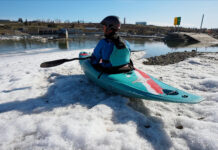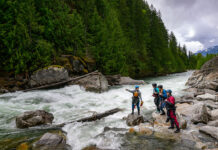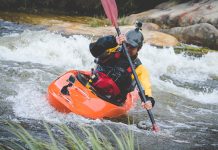What is a drysuit? Simply put, a drysuit is a specialized piece of paddlesports clothing. Drysuits provide a high level of protection from cold water immersion and a broad range of comfort in all but the hottest weather. For many paddlers, drysuits are money well spent—the best investment you can make in safety and comfort paddling.
When to use a drysuit
A drysuit is appropriate to use anytime the water temperature is cold enough that you would be at risk of hypothermia if you went for a swim. This might sound extreme, but it really isn’t. Summertime water temperatures are cold enough in much of North America to warrant a drysuit for sea kayaking or whitewater boating. Water conducts heat away from your body 25 times faster than air. This means that even cool water temperatures can be dangerous if you don’t dress appropriately.
Many people choose neoprene wetsuits for cold water protection, but drysuits are more effective. Drysuits offer better protection from cold water immersion and a broader comfort range in warm weather. Any way you slice it, drysuits are a secret weapon for paddling comfort and safety.
How does a drysuit work?
Drysuits work by preventing cold water from touching your skin. If water can’t contact your skin, you won’t be subject to the rapid cooling effects of H20. Drysuits accomplish this feat by sealing your body inside a watertight envelope. The suit itself is made of waterproof materials, neck, wrist and foot openings are sealed with super-tight latex gaskets, and entry is provided by a waterproof zipper. Different suits use slightly different materials and closures, but the general concept is the same—water stays out, you stay warm.
The drysuit doesn’t offer any insulation itself, but anything under the suit will stay (mostly) dry. This means you have the option of increasing or decreasing insulation under the suit to adapt to different water and air temperatures. The ability to vary insulation to meet different conditions is the key reason that drysuits are so versatile.
Buying a drysuit
Common features
All drysuits have a few features in common. The most obvious of these are latex wrist and neck gaskets that seal tightly against your skin and limit the amount of moisture that can enter the suit. Many suits have latex or fabric socks at the feet rather than gaskets. These are much easier to use than ankle gaskets and keep your feet warmer.
A second common feature is some kind of closure. You need to be able to get into and out of the suit somehow and designers have hit on a few angles that work well. When you start looking at suits, one of the main decisions you’ll need to make is what type of entry you prefer. It is definitely worth trying on different suits with different zipper placement to figure out what works best for you.
Here are a few of the main types of entry design.
Types of drysuits
Font-zip drysuits
Front-zip drysuits place the entry zipper across the chest of the drysuit beginning at the upper right shoulder and angling downward toward the waist on the left. The advantage of the front-zip entry is that it is the easiest configuration to zip closed by yourself. With a little practice, most paddlers can zip the suit all the way closed at the top and reach the zipper tab to open the suit at the end of the day.
The disadvantage of front-zip suits is that they place the bulky zipper right across your chest where it can be uncomfortable. They also tend to be less dry on the boat than rear-zip suits since any sprayskirt tunnel incorporated into the design will need to be penetrated by a flap that allows the zipper to be opened and closed.
Rear-zip
Rear-zip suits open and close across the back of the shoulders. This design places the zipper away from the chest. The advantage is that there are no penetrations through the sprayskirt tunnel on the suit. A drier sprayskirt tunnel means a drier boat, so rear-zip designs are popular with whitewater kayakers and rough water sea kayakers.
Rear-zip suits work great once you’re zipped inside, but they can be tricky to close. Depending on how flexible you are, you may not be able to zip the suit closed by yourself. This isn’t a problem if you’re spending a day out on the river with friends, but it might be an obstacle to wearing the suit on solo adventures.
Two-piece
There are a few suits on the market that mate together top and bottom. The idea is that you can use the top section separately as a drytop if you don’t need the full protection of your drysuit. The most common of these systems use a conventional drytop with a double tunnel and a specialized set of paddling bib pants that have a matching tunnel. The two tunnels are rolled together and tucked inside the tunnel of a neoprene sprayskirt for security.
The drytop/bib drysuit option is versatile, but it doesn’t provide nearly the amount of protection that a true drysuit does. In practice, the roll closure is difficult to keep sealed and some amount of water does enter the suit if you swim. This means this kind of system doesn’t really function as a true drysuit. If you already have a good drytop, adding a set of bibs can stretch your season and improve your safety, but a dedicated drysuit will function better.
There are some drysuits on the market that place a waterproof zipper between the top and bottom of the suit. This allows the top of the suit to be worn as a drytop by itself, or to be combined with the drysuit bottoms to create a full suit. The use of a waterproof zipper creates a truly dry closure between the two halves of the suit. If you’re looking for the versatility of one suit that can be worn as a drysuit or a drytop, this is the most secure option.
Semi-drysuits
One last type of suit worth mentioning is the semi-drysuit. These suits typically have all the features of conventional drysuits but replace the dry latex neck gasket with a neoprene closure. This closure isn’t as dry as a latex gasket but can be adjusted for comfort and ventilation. The thinking is that if you capsize and come out of your kayak, your head and neck will quickly be above water, so you won’t get that much water in through the looser neck opening.
Semi-drysuits can be a good option for expedition canoeing, where you’re unlikely to put your head underwater if you flip. They also might be the right choice for someone paddling in very hot air conditions and cold water. Some folks have sensitivity to latex and aren’t able to wear a suit with a neck gasket. In these circumstances a semi-drysuit could be a good choice. Just remember that it won’t keep you as dry as a true drysuit. For most folks, a true drysuit is the best option.
Drysuit materials
Drysuit fabrics and zippers are the two main areas of variation between models and manufacturers.
Fabrics
Years ago, drysuits were built from urethane coated nylon fabrics that didn’t breathe. Water couldn’t get in, but your perspiration couldn’t get out. This meant that in warm conditions you would stew in the suit. Back in the non-breathable days, drysuits were really only an option if the water and the air temperatures were freezing.
It took the advent of breathable fabrics to make truly versatile drysuits possible. The best known of these is Gore-Tex, which is a family of fabrics made from ePTFE (expanded polytetrafluoroethylene). Other common breathable fabrics are produced by laminating breathable urethane coatings to a variety of face fabrics. Both Gore-Tex and proprietary waterproof breathable fabrics are proven, effective options in drysuit materials.
Breathable fabrics allow some moisture to escape from the inside of the fabric to the outside. All work best when the environment on the inside of the suit is warmer and more humid than the outside air. If the outer fabric of your suit gets soaked, it won’t breathe as well. In practice, this means that even breathable suits can get a little sweaty when you’re working hard. Even so, they are much more comfortable than non-breathable suits. So much so that it’s become difficult to find a suit made from non-breathable coated fabrics. The breathable suits just work better.
As far as fabrics go, Gore-Tex has a strong reputation as a durable, breathable material for drysuits. WL Gore even goes so far as to back their materials with a robust warranty that covers delamination. This means that Gore-Tex suits are among the most durable and strongly backed options on the market.
The downside of Gore-Tex is cost, which can be considerably higher than the cost of other effective fabrics. Many quality manufacturers choose alternatives to Gore-Tex for their suits and most companies that build Gore-Tex suits offer a lower-cost alternative in a proprietary fabric. Fabric alone shouldn’t necessarily dictate which suit you choose. There are lots of good options out there in a wide range of materials.
Zippers
Drysuits require waterproof zippers. The two types available are metal and plastic. The metal waterproof zipper has long been considered the best, driest option, but in recent years new waterproof plastic zippers have come onto the market and are giving the metal option a run for its money. At this point it would be difficult to say whether metal or plastic waterproof zippers are truly superior. A quality drysuit manufacturer will choose the zipper that is best matched to the design of the suit. Both metal and plastic options are effective.
Special features
These days, drysuits come standard with a wide range of specialty features. The most common of these are double tunnels and relief zippers, but there are a few more worth considering.
Double tunnel
Double tunnel drysuits have a fabric tunnel sewn into the suit that goes over the top of the tunnel on your sprayskirt. This tunnel snugs up tight with a velcro closure and dramatically limits the amount of water than can get into your kayak between your body and your sprayskirt. Whitewater kayakers will prefer this option as will sea kayakers who venture out into the rough stuff.
Relief zips
Once considered a luxury, relief zips are now standard on a range of drysuits. They are worth every penny of extra cost that they add to a suit. Simply put, a relief zip makes it possible to answer the call of nature without completely removing your suit. This means you’ll stay warmer and will be more likely to hydrate properly. Men’s suits have a relief zipper at the front. Women’s suits feature a zipper around the edge of the seat.
Socks
Another option that is rapidly becoming standard issue, socks are definitely worth having. It’s much easier to slide your feet in and out of socks than it is to force them through ankle gaskets. Better still, wool socks inside waterproof socks, inside the fully-sealed drysuit stay toasty warm and dry.
The two main types of socks are latex and fabric. Fabric socks breathe a bit and keep your feet a little drier. Latex socks are a little more durable and don’t bunch up inside your booties or water shoes. Both options work well and can be repaired or replaced if needed.
Pockets
Sleeve pockets, chest pockets, thigh pockets. There are lots of options out there. Some pockets can be custom added to suits. Others come standard as part of a specialty suit design.
Reinforced wear areas
Heavy-duty fabrics on seat and knees are a good idea, especially for whitewater kayakers who will be scouting and portaging in rugged terrain. Many suits come with this feature as standard. Others offer it as a custom option.
Hoods
Specialty sea kayaking drysuits frequently feature a hood that can be deployed to keep the rain off your head and block the wind.
How should a drysuit fit?
Your drysuit should fit comfortably over whatever insulating layers you plan to wear. It’s important for the suit to fit when you’re seated in your kayak. You don’t want it to bind when you sit upright or when you set up for a roll. Common fit problems include a suit being too short in the torso so that it binds in the crotch, a suit being too tight across the shoulders so that it limits mobility for rolls, and a suit being too tight around the waist, which causes limited mobility all around.
How tight should a drysuit neck seal be?
Speaking of tight, how about that neck gasket? New suits with new gaskets can fit so tight your face will turn red. Not good! You want the gasket to be just tight enough to keep water out of your suit without cutting off circulation. If the gasket is too tight, you’ll need to make an adjustment.
Over time, neck gaskets stretch out a bit and become more comfortable. A good trick for loosening your neck gasket is to stretch it over an oversized object like a mixing bowl. Leave the bowl in place for several days and try on the suit again. In most cases the gasket will stretch enough to fit properly. Don’t be afraid to try this several times before moving on to more drastic measures.
If you can’t get your neck gasket to fit comfortably by stretching, you can cut the gasket down to create a looser fit. This is a tricky process and if you do it incorrectly you could tear the gasket. Check with the manufacturer of your suit for tips before you resort to cutting your neck gasket.
How much does a drysuit cost?
Depending on features and materials, drysuits range from about $500 to well over $1,000. Many of the most popular models sell for $800 to $1,000. This is obviously a considerable outlay in cash for a piece of clothing. On the other hand, the versatility and comfort that a drysuit provides is unmatched. When it comes to comfort and safety, drysuits are worth the investment.
Where to buy a drysuit
If you’re lucky enough to have a serious paddling store in your hometown, pay them a visit. Buying a drysuit from your local shop is a great way to ensure you’ll end up with a suit that fits and has the features you need for your local waters. Chances are, the folks at the shop will have tried one or more suits themselves and will be able to offer up an educated opinion on what will work best for you.
If you don’t have a local connection, you can search out suits on the web. Our Paddling Buyer’s Guide is a great place to start. It compares a range of suits from top manufacturers and provides links for online shopping.
Where to rent a drysuit
Depending on where you live, you may be able to rent a drysuit from a local paddling shop. Some manufacturers also provide rental services as a way for you to take their products for an extended test drive. A few specialty retailers and schools will ship a drysuit to you anywhere in the country. A web search for kayak drysuit rental will be your best bet in finding a drysuit to rent.
How to use a drysuit
What to wear under a drysuit
What you wear under a drysuit will dictate how comfortable you are in and out of the water. You can read our complete guide on What To Wear Kayaking for the nitty-gritty of how to stay comfortable in a full range of conditions.
The basics of layering under a drysuit come down to moisture management and insulation. You’ll want to wear a wicking base layer to help move moisture away from your skin and toward the outer fabric of the suit. In warm weather, this wicking base layer may be the only thing you wear under your drysuit. In colder conditions, you’ll want to wear a layer of wicking fleece over the top of this base layer.
Wicking fleece works better than conventional fleece inside a drysuit. It is woven in a way that draws moisture from the inside of the fabric toward the outer fabric face. This active wicking process works with your body heat to move perspiration away from your skin so you’ll feel drier, warmer and more comfortable. In some cases, wicking fleece is so effective you might choose to wear it alone, next-to-skin rather than layering over a thinner base layer.
You can layer under a drysuit with any appropriate wicking clothes from your conventional outdoor closet, but specialized paddling layers work better. These clothes are cut to move seams away from armpits or waist where they might chafe while paddling. They typically have longer tails and higher waists to prevent gapping while seated. You can even buy a one-piece fleece suit to wear under your drysuit for low-bulk, gap-free insulation.
What you shouldn’t wear under a drysuit is anything that absorbs moisture and is slow to dry. Cotton is out. Merino wool works but is slower to dry than synthetics.
Avoid wearing rings, watches or other jewelry that could damage latex wrist gaskets. You’ll want to remove all these items before trying on any drysuit.
How to put a drysuit on
The easiest way to put on a drysuit is feet, waist, hands, head. Find a padded, clean surface to stand on. A chair can help. Slide your feet into the legs and fully down into the drysuit’s socks. Next, pull the suit up to your waist. Slide your hands into the arms and get them fully through the wrist gaskets one at a time. Now comes the tricky part. Grasp the neck gasket with both hands and pull outward to expand the gasket. Duck your head into the suit and under the gasket and press through the gasket until it drops below your chin. You’re in! Zip the zipper and you’re ready to go.
How do you get a drysuit off?
To remove a drysuit, reverse the steps mentioned above. Open the zipper. Grasp the neck gasket with your hands and pull outward to stretch the gasket. Pull the gasket over your head and duck your head out of the body of the suit. Pull your hands out of the wrist gaskets. It is usually easiest to pull these gaskets inside out. Once your hands are out, the suit can be removed like a pair of pants.
Taking care of your drysuit
Repair
All our tools wear with time. Drysuits are no exception. Latex gaskets degrade with time and must be replaced. Waterproof fabrics can develop pinhole leaks that need to be patched. The best manufacturers offer repair services that will get your suit back up and running when it comes time for scheduled maintenance.
How long should a drysuit last?
The lifespan of a drysuit has a bit to do with materials, but more to do with how you care for the suit. Gaskets deteriorate with age and with frequent use may need to be replaced every three to five years. Waterproof fabrics can develop small pinholes over time. Fabric socks are prone to this problem because of the wear and tear they endure inside paddling shoes. A quality manufacturer can test your suit for leaks and make repairs for a modest cost.
What’s the maximum lifespan of a drysuit? A long time. 10 years isn’t uncommon, particularly if the suit is well-maintained. Longer is possible.
How to dry out a drysuit
It’s a good idea to dry your drysuit after each use. This prevents destructive mildew from forming on the fabric. Rinse your suit in fresh water if you’ve been paddling in the sea. Hang the suit out of the direct sun to dry. You may need to turn the suit inside out to ensure it dries completely.
How to clean a drysuit
If your drysuit is grungy, or if the outer fabric isn’t beading water anymore, it’s time for a clean. Follow the manufacturer’s recommendations when cleaning your drysuit. In most cases, it’s recommended that you use a front-loading machine or a top-loader without an agitator. Use a technical soap, not conventional laundry detergent. Detergents will destroy the Durable Water Repellent (DWR) treatment on the face fabric of the suit. Hang the suit to dry.
If you need to restore your suit’s DWR, use a spray-on treatment. You can’t put your suit in the dryer (it would destroy the gaskets), so you’ll want to use a hand iron to complete the DWR treatment. Details of how to do this correctly can be found on the manufacturer’s website.
How to store a drysuit
Store your drysuit in a cool, dry place out of the sun. UV radiation breaks down drysuit gaskets so the more time they spend in the dark the better. It’s okay to store your suit in a duffel bag or hanging over a stout hanger. There isn’t a particular way the suit needs to be folded.
Follow the recommendations from the manufacturer about what to do with your suit’s zippers. Some zippers should be stored slightly open, while others should be zipped up tight. Proper storage will ensure the zipper remains waterproof for the life of the suit.
Don’t compress your suit or store it in a hot place. This can cause the latex gaskets to become sticky and make them adhere to themselves. Once this happens, the gaskets usually tear and need to be replaced.
How do you change a drysuit gasket?
Changing a drysuit gasket can be tricky. It’s definitely something that is within reach of a skilled DIY paddler, but it’s worth doing some careful research before you dig into the project.
The basic process involves cutting away the old gasket where it meets the fabric of the suit. The opening is then stretched over an oversized object (PVC pipe sections are commonly used). The surface of the old gasket is prepped and a new gasket is stretched over it and glued in place with Aquaseal. When the sealant is cured, the repair is complete.
Replacing a gasket isn’t difficult, but it can get messy. If you’re going to try this on your own, be sure to do a little homework ahead of time. If you don’t feel like tackling this project at home, you can send your suit in to the manufacturer for a professional gasket replacement.









